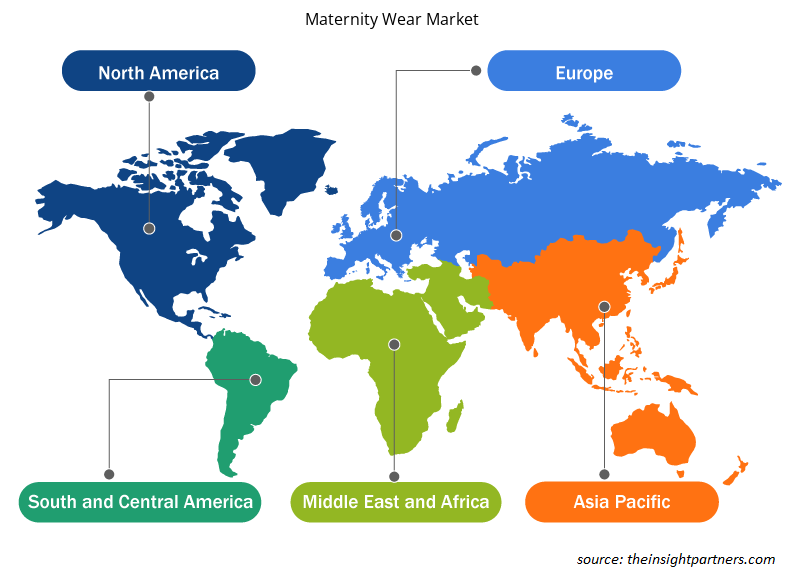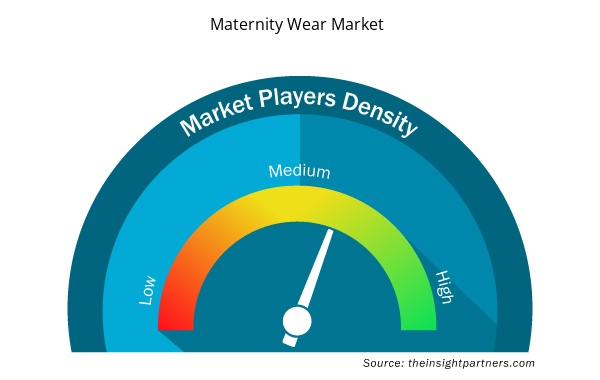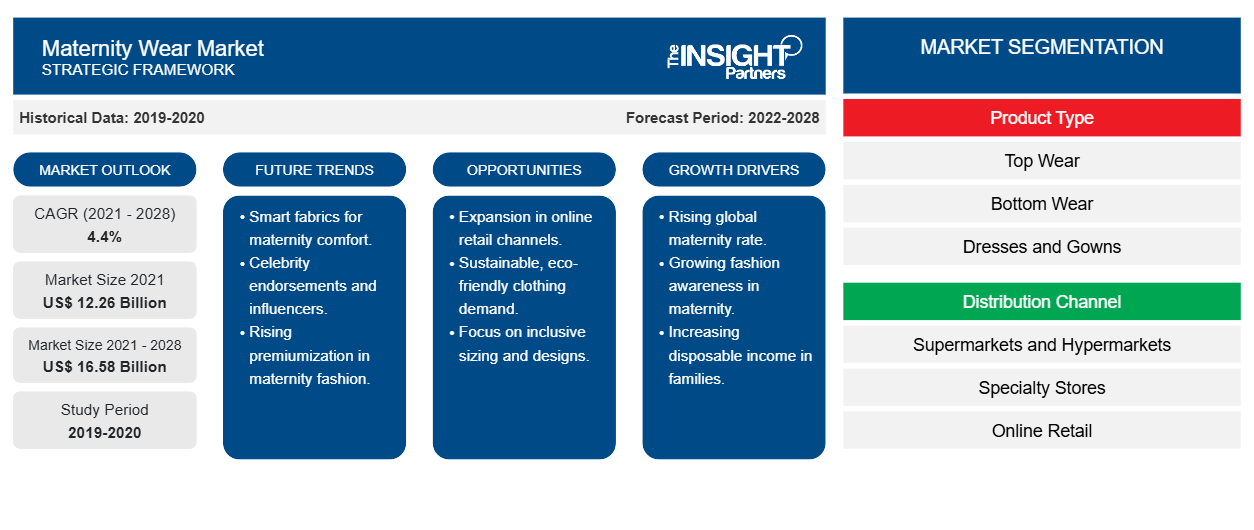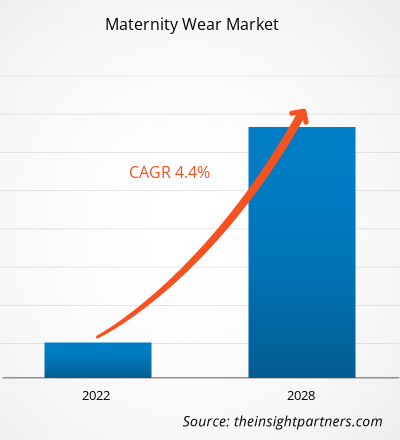El mercado de ropa de maternidad se valoró en US$ 12.257,41 millones en 2021 y se proyecta que alcance los US$ 16.578,64 millones en 2028; se espera que crezca a una CAGR del 4,4% de 2021 a 2028.
La ropa de maternidad generalmente se crea con un ajuste holgado y apropiado que contiene elástico, lengüetas y tela elástica, como elastano y spandex, para brindar mayor comodidad a la consumidora durante el embarazo.
En 2020 , la región de Asia y el Pacífico tuvo la mayor participación en el mercado mundial de ropa de maternidad , mientras que se espera que América del Norte registre la CAGR más alta durante el período de pronóstico. Según el informe del Banco Mundial, en los EE. UU. hay un promedio del 85 % de mujeres embarazadas que trabajan. Por lo tanto, está aumentando la demanda de ropa de maternidad y tallas grandes en ropa formal en la sección de vestidos y batas formales. Este es un factor importante que contribuye al crecimiento del mercado de ropa de maternidad en América del Norte.
Impacto de la pandemia de COVID-19 en el mercado de ropa de maternidad
La pandemia de COVID-19 ha afectado negativamente a muchas industrias, incluida la industria de bienes de consumo. La pandemia creó dificultades operativas debido a los confinamientos, el cierre de empresas y las interrupciones de la cadena de suministro. Las tiendas minoristas de ropa y prendas de vestir registraron grandes pérdidas en ventas. Los resultados financieros publicados por marcas de moda como el grupo español Inditex y la sueca H & M pusieron de manifiesto la enormidad del impacto de la pandemia. Además, el comercio electrónico experimentó un beneficio duradero de la pandemia, ya que la mayoría de los compradores en línea consideran el comercio electrónico como una opción pospandémica. Además, se proyecta que el aumento de las tasas de vacunación, la reactivación de las actividades de fabricación y la relajación de las regulaciones gubernamentales influyan positivamente en el mercado mundial de ropa de maternidad durante el período de pronóstico.
Personalice este informe según sus necesidades
Obtendrá personalización en cualquier informe, sin cargo, incluidas partes de este informe o análisis a nivel de país, paquete de datos de Excel, así como también grandes ofertas y descuentos para empresas emergentes y universidades.
- Obtenga las principales tendencias clave del mercado de este informe.Esta muestra GRATUITA incluirá análisis de datos, desde tendencias del mercado hasta estimaciones y pronósticos.
Perspectivas del mercado
La adopción de estrategias de crecimiento empresarial impulsa el crecimiento del mercado
Los actores bien establecidos en el mercado adoptan varias estrategias para superar los desafíos actuales y futuros para la expansión de la empresa. Por ejemplo, Isabella Oliver adoptó una estrategia de penetración en el mercado al lanzar un programa de alquiler de ropa de maternidad para mejorar su alcance. El 20 de enero de 2020, la marca lanzó nuevamente un nuevo programa de alquiler para volverse circular y aumentar la longevidad de la ropa de maternidad. Isabella Oliver ofreció a sus clientes la nueva gama de opciones para alquilar un vestido, incluida la ropa de fiesta y los elementos básicos del embarazo, durante dos semanas, antes de devolverlo sin cargo. La marca incluso se encarga de la limpieza en seco. Los clientes también pueden comprar el producto. La idea de alquilar ropa de maternidad es alentar a los clientes a ser más ecológicos y eliminar los efectos de la moda rápida. Entonces, las innovaciones y las penetraciones de productos llevaron a un aumento en la demanda de ropa de maternidad. Estos factores están impulsando el crecimiento del mercado de ropa de maternidad.
Información sobre el canal de distribución
Según el canal de distribución, el mercado de ropa de maternidad se segmenta en supermercados e hipermercados, tiendas especializadas, venta minorista en línea y otros. Se espera que el segmento minorista en línea registre la CAGR más alta durante el período de pronóstico. El comercio electrónico jugó un papel vital durante los meses iniciales de la pandemia de COVID-19, ya que no se permitió que las tiendas minoristas físicas operaran. Durante los confinamientos, las personas utilizaron cada vez más plataformas de comercio electrónico para comprar productos esenciales y no esenciales. La crisis económica debido al brote de COVID-19 resultó en una reducción de los ingresos disponibles de las mujeres. Sin embargo, la demanda de ropa de maternidad no se vio afectada. Como resultado, es probable que los precios competitivos se conviertan en una característica clave del panorama completo en el futuro. Se proyecta que este factor potencialmente impulsará el crecimiento del mercado para el segmento minorista en línea durante el período de pronóstico.
Información sobre el tipo de producto
Según el tipo de producto, el mercado de ropa de maternidad se segmenta en ropa superior, ropa inferior, vestidos y batas, y ropa interior . El segmento de ropa superior representó una mayor participación de mercado en 2020, y se espera que el segmento de vestidos y batas registre una CAGR más alta durante el período de pronóstico. La ropa superior de maternidad consta de ropa formal y ropa informal. Además, la demanda de ropa formal de maternidad está aumentando debido al creciente número de mujeres trabajadoras. La ropa superior formal de maternidad consta de kurtis, blusas, vestidos de tirantes de material suave, blazers y gabardinas con capas dobles. La ropa informal comprende túnicas, vestidos largos y sudaderas y camisetas de gran tamaño. La ropa de maternidad está hecha de telas de la mejor calidad con materiales naturales y cómodos, como algodón, modal y bambú , ya que son suaves y permiten una respiración constante. Las mujeres embarazadas tienden a elegir el material de acuerdo con los cambios estacionales. En verano, prefieren telas de lino que repelen el calor para facilitar la circulación del aire, mientras que en invierno, prefieren abrigos de lana cálidos para prevenir el frío.
Algunos actores que operan en el mercado de ropa de maternidad son Gap Inc, Seraphine, Isabella Oliver, H and M Hennes and Mauritz AB, Brunelli and Co SRL, Mothercare, Boob Design, SHAICO Fashion Pvt. Ltd, Pink Blush Maternity y Organic & More.
Perspectivas regionales del mercado de ropa de maternidad
Los analistas de Insight Partners explicaron en detalle las tendencias y los factores regionales que influyen en el mercado de ropa de maternidad durante el período de pronóstico. Esta sección también analiza los segmentos y la geografía del mercado de ropa de maternidad en América del Norte, Europa, Asia Pacífico, Oriente Medio y África, y América del Sur y Central.

- Obtenga datos regionales específicos para el mercado de ropa de maternidad
Alcance del informe de mercado de ropa de maternidad
| Atributo del informe | Detalles |
|---|---|
| Tamaño del mercado en 2021 | US$ 12,26 mil millones |
| Tamaño del mercado en 2028 | US$ 16,58 mil millones |
| CAGR global (2021-2028) | 4,4% |
| Datos históricos | 2019-2020 |
| Período de pronóstico | 2022-2028 |
| Segmentos cubiertos | Por tipo de producto
|
| Regiones y países cubiertos | América del norte
|
| Líderes del mercado y perfiles de empresas clave |
|
Densidad de actores del mercado: comprensión de su impacto en la dinámica empresarial
El mercado de ropa de maternidad está creciendo rápidamente, impulsado por la creciente demanda de los usuarios finales debido a factores como la evolución de las preferencias de los consumidores, los avances tecnológicos y una mayor conciencia de los beneficios del producto. A medida que aumenta la demanda, las empresas amplían sus ofertas, innovan para satisfacer las necesidades de los consumidores y aprovechan las tendencias emergentes, lo que impulsa aún más el crecimiento del mercado.
La densidad de actores del mercado se refiere a la distribución de las empresas o firmas que operan dentro de un mercado o industria en particular. Indica cuántos competidores (actores del mercado) están presentes en un espacio de mercado determinado en relación con su tamaño o valor total de mercado.
Las principales empresas que operan en el mercado de ropa de maternidad son:
- brecha inc
- Serafina
- Isabella Oliver
- H&M Hennes y Maurits
- Brunelli & Cía. SRL
Descargo de responsabilidad : Las empresas enumeradas anteriormente no están clasificadas en ningún orden particular.

- Obtenga una descripción general de los principales actores clave del mercado de ropa de maternidad
Informe Destacado
- Tendencias progresivas de la industria en el mercado de ropa de maternidad para ayudar a los actores a desarrollar estrategias efectivas a largo plazo
- Estrategias de crecimiento empresarial adoptadas por los mercados desarrollados y en desarrollo
- Análisis cuantitativo del mercado de ropa de maternidad de 2019 a 2028
- Estimación de la demanda mundial de ingredientes lácteos
- Análisis de las cinco fuerzas de Porter para ilustrar la eficacia de los compradores y proveedores que operan en la industria
- Avances recientes para comprender el escenario competitivo del mercado
- Tendencias y perspectivas del mercado, así como factores que impulsan y restringen el crecimiento del mercado de ropa de maternidad
- Asistencia en el proceso de toma de decisiones destacando las estrategias de mercado que sustentan el interés comercial y conducen al crecimiento del mercado.
- El tamaño del mercado de ropa de maternidad en varios nodos
- Descripción detallada y segmentación del mercado, así como la dinámica de la industria de ropa de maternidad.
- Tamaño del mercado de ropa de maternidad en varias regiones con oportunidades de crecimiento prometedoras
- Análisis histórico (2 años), año base, pronóstico (7 años) con CAGR
- Análisis PEST y FODA
- Tamaño del mercado Valor/volumen: global, regional, nacional
- Industria y panorama competitivo
- Conjunto de datos de Excel



Report Coverage
Revenue forecast, Company Analysis, Industry landscape, Growth factors, and Trends

Segment Covered
This text is related
to segments covered.

Regional Scope
North America, Europe, Asia Pacific, Middle East & Africa, South & Central America

Country Scope
This text is related
to country scope.
Preguntas frecuentes
The global maternity wear market is driven by the rising number of pregnant working women coupled with the adoption of business growth strategies by the market players.
Based on distribution channel, the supermarkets and hypermarkets segment held the largest market share in 2020. Supermarkets and hypermarkets, considered as an effective distribution channel, are large retail stores that offer a wide range of maternity clothes. Many leading manufacturers of maternity clothes target selling their products through prominent supermarkets and hypermarkets chains, such as Mom & Baby, Mother Care, and FirstCry, as there is high customer traffic in these stores. This factor is also driving the popularity of supermarkets and hypermarkets for purchasing maternity clothes.
Top wear accounted for a major share in 2020. Maternity top-wear cloth consists of formal wear and casual wear. The demand for formal maternity top wear is rising due to the increasing number of working females. Formal maternity top-wear consists of kurtis, blouses, soft material tank dresses, blazers, and trench coats with double layers, and casual wear comprises tunics, maxi dresses, and oversize sweatshirts and t-shirts.
The major players operating in the global maternity wear market are Gap Inc, Seraphine, Isabella Oliver, H & M Hennes and Maurits, Brunelli & Co. S.R.L., Mothercare, Boob Design, Pinkblush Maternity, Adidas America Inc., and Organic and More among others.
In 2020, Asia Pacific held the largest share in the global maternity wear market. Asia-Pacific continent comprises several developing and developed economies such as India, China, Japan, South Korea, and Australia. These emerging countries are witnessing an increase in spending by new mothers to be over their first pregnancy photo-shoots, accompanied by growing purchasing capacity of women in this region.
Trends and growth analysis reports related to Consumer Goods : READ MORE..
The List of Companies - Maternity Wear Market
- Gap Inc
- Seraphine
- Isabella Oliver
- H & M Hennes and Maurits
- Brunelli & Co. S.R.L
- Mothercare
- Boob Design
- Shaico Design Pvt. Ltd.
- Pinkblush Maternity
- Organic & More
The Insight Partners performs research in 4 major stages: Data Collection & Secondary Research, Primary Research, Data Analysis and Data Triangulation & Final Review.
- Data Collection and Secondary Research:
As a market research and consulting firm operating from a decade, we have published and advised several client across the globe. First step for any study will start with an assessment of currently available data and insights from existing reports. Further, historical and current market information is collected from Investor Presentations, Annual Reports, SEC Filings, etc., and other information related to company’s performance and market positioning are gathered from Paid Databases (Factiva, Hoovers, and Reuters) and various other publications available in public domain.
Several associations trade associates, technical forums, institutes, societies and organization are accessed to gain technical as well as market related insights through their publications such as research papers, blogs and press releases related to the studies are referred to get cues about the market. Further, white papers, journals, magazines, and other news articles published in last 3 years are scrutinized and analyzed to understand the current market trends.
- Primary Research:
The primarily interview analysis comprise of data obtained from industry participants interview and answers to survey questions gathered by in-house primary team.
For primary research, interviews are conducted with industry experts/CEOs/Marketing Managers/VPs/Subject Matter Experts from both demand and supply side to get a 360-degree view of the market. The primary team conducts several interviews based on the complexity of the markets to understand the various market trends and dynamics which makes research more credible and precise.
A typical research interview fulfils the following functions:
- Provides first-hand information on the market size, market trends, growth trends, competitive landscape, and outlook
- Validates and strengthens in-house secondary research findings
- Develops the analysis team’s expertise and market understanding
Primary research involves email interactions and telephone interviews for each market, category, segment, and sub-segment across geographies. The participants who typically take part in such a process include, but are not limited to:
- Industry participants: VPs, business development managers, market intelligence managers and national sales managers
- Outside experts: Valuation experts, research analysts and key opinion leaders specializing in the electronics and semiconductor industry.
Below is the breakup of our primary respondents by company, designation, and region:

Once we receive the confirmation from primary research sources or primary respondents, we finalize the base year market estimation and forecast the data as per the macroeconomic and microeconomic factors assessed during data collection.
- Data Analysis:
Once data is validated through both secondary as well as primary respondents, we finalize the market estimations by hypothesis formulation and factor analysis at regional and country level.
- Macro-Economic Factor Analysis:
We analyse macroeconomic indicators such the gross domestic product (GDP), increase in the demand for goods and services across industries, technological advancement, regional economic growth, governmental policies, the influence of COVID-19, PEST analysis, and other aspects. This analysis aids in setting benchmarks for various nations/regions and approximating market splits. Additionally, the general trend of the aforementioned components aid in determining the market's development possibilities.
- Country Level Data:
Various factors that are especially aligned to the country are taken into account to determine the market size for a certain area and country, including the presence of vendors, such as headquarters and offices, the country's GDP, demand patterns, and industry growth. To comprehend the market dynamics for the nation, a number of growth variables, inhibitors, application areas, and current market trends are researched. The aforementioned elements aid in determining the country's overall market's growth potential.
- Company Profile:
The “Table of Contents” is formulated by listing and analyzing more than 25 - 30 companies operating in the market ecosystem across geographies. However, we profile only 10 companies as a standard practice in our syndicate reports. These 10 companies comprise leading, emerging, and regional players. Nonetheless, our analysis is not restricted to the 10 listed companies, we also analyze other companies present in the market to develop a holistic view and understand the prevailing trends. The “Company Profiles” section in the report covers key facts, business description, products & services, financial information, SWOT analysis, and key developments. The financial information presented is extracted from the annual reports and official documents of the publicly listed companies. Upon collecting the information for the sections of respective companies, we verify them via various primary sources and then compile the data in respective company profiles. The company level information helps us in deriving the base number as well as in forecasting the market size.
- Developing Base Number:
Aggregation of sales statistics (2020-2022) and macro-economic factor, and other secondary and primary research insights are utilized to arrive at base number and related market shares for 2022. The data gaps are identified in this step and relevant market data is analyzed, collected from paid primary interviews or databases. On finalizing the base year market size, forecasts are developed on the basis of macro-economic, industry and market growth factors and company level analysis.
- Data Triangulation and Final Review:
The market findings and base year market size calculations are validated from supply as well as demand side. Demand side validations are based on macro-economic factor analysis and benchmarks for respective regions and countries. In case of supply side validations, revenues of major companies are estimated (in case not available) based on industry benchmark, approximate number of employees, product portfolio, and primary interviews revenues are gathered. Further revenue from target product/service segment is assessed to avoid overshooting of market statistics. In case of heavy deviations between supply and demand side values, all thes steps are repeated to achieve synchronization.
We follow an iterative model, wherein we share our research findings with Subject Matter Experts (SME’s) and Key Opinion Leaders (KOLs) until consensus view of the market is not formulated – this model negates any drastic deviation in the opinions of experts. Only validated and universally acceptable research findings are quoted in our reports.
We have important check points that we use to validate our research findings – which we call – data triangulation, where we validate the information, we generate from secondary sources with primary interviews and then we re-validate with our internal data bases and Subject matter experts. This comprehensive model enables us to deliver high quality, reliable data in shortest possible time.


 Obtenga una muestra gratuita de este informe
Obtenga una muestra gratuita de este informe